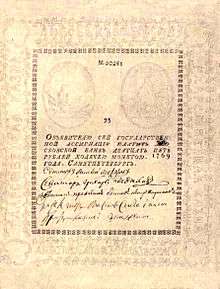Assignation ruble
.jpg)
Assignation ruble (Russian: ассигнационный рубль; assignatsionny rubl) was the first paper currency of Russia. It was used from 1769 until 1849. Assignation ruble had a parallel circulation with the silver ruble; there was an ongoing market exchange rate for these two currencies. In later period, the value of the Assignation ruble was considerably below that of the silver ruble.
History

In 1768, during the reign of Catherine the Great, the Assignation Bank was instituted to issue the government paper-money. It opened in St. Petersburg and in Moscow in 1769. Several bank branches were afterwards established in others of the towns, called government towns. Notes of 100, 75, 50, and 25 roubles, were issued upon payment of similar sums in copper money, which were refunded upon the presentation of those paper notes.
The emergence of Assignation rubles was due to large government spending on military needs, leading to a shortage of silver in the treasury (as all the calculations, especially in foreign trade, were conducted exclusively in silver and gold coins).
The lack of silver, and huge masses of copper coins in the Russian domestic market led to the fact that large payments were extremely difficult to implement. So this has necessitated the introduction of some kind of bills for large transactions.
The initial capital of the Assignation Bank amounted to 1 million rubles copper coins - 500 thousand rubles each in St. Petersburg and in the Moscow offices; thus the total emission of banknotes was also limited to one million rubles.
Issuance of the assignation ruble

Between 1769 and 1843 five issues of assignation ruble were emitted. Virtually all (except some denominations of the 1802 issue) were issued across a number of years. One issue (1785–87) was known to have two separate series.
| Issue | Denom | Dates | Comments |
|---|---|---|---|
| 1769 Issue[2] | 25 Rubles | 1769–73 | |
| 50 Rubles | 1769–73 | ||
| 75 Rubles | 1769–73 | ||
| 100 Rubles | 1769–73 | ||
| 1774 Issue[2] | 25 Rubles | 1774–84 | |
| 50 Rubles | 1774–84 | ||
| 100 Rubles | 1774–84 | ||
| 1785–87 Issue[2] | 5 Rubles | 1787–1802 1803–18 |
|
| 10 Rubles | 1787–1801 1803–17 |
||
| 25 Rubles | 1785–1802 1803–18 |
||
| 50 Rubles | 1785–1802 1803–18 |
||
| 100 Rubles | 1785–1801 1803–18 |
||
| 1802 Issue[3] | 5 Rubles | 1802 | |
| 10 Rubles | 1802–03 | ||
| 25 Rubles | 1802 | ||
| 100 Rubles | 1802 | ||
| 1818–43 Issue[3][4] | 5 Rubles | 1819–43 | |
| 10 Rubles | 1819–43 | ||
| 20 Rubles | 1822 | ||
| 25 Rubles | 1818–43 | ||
| 50 Rubles | 1818–43 | ||
| 100 Rubles | 1819–43 | ||
| 200 Rubles | 1819–43 |
Financial reforms of 1839-1843

In 1843, all Assignation rubles were withdrawn from circulation, and replaced with the state credit notes (Russian: государственные кредитные билеты) in denominations of 1, 3, 5, 10, 25, 50 and 100 rubles. The Assignation Bank was replaced by the State Bank, and formally ceased operations in 1848. All this came about through the monetary reforms of 1839-43, which improved the Russian fiscal system considerably. These were the reforms of Georg von Cancrin, the Russian Minister of Finance from 1823 to 1844.
See also
Notes
References
- Cuhaj, George S. (2010). Paper Money General Issues 1368-1960 (13 ed.). Krause Publications. ISBN 978-1-4402-1293-2.
- Shishanov V. The Assignats of 1802-1803 // Journal of the Russian numismatic society. 1999. №68. P.58-69.
External links
- History of Russian Currency
- Assignation Bank: Encyclopedia of St. Petersburg